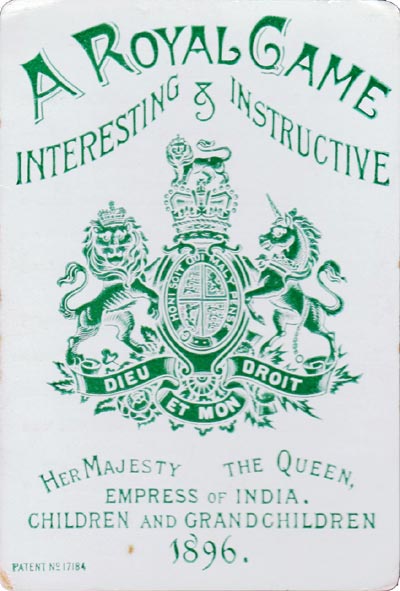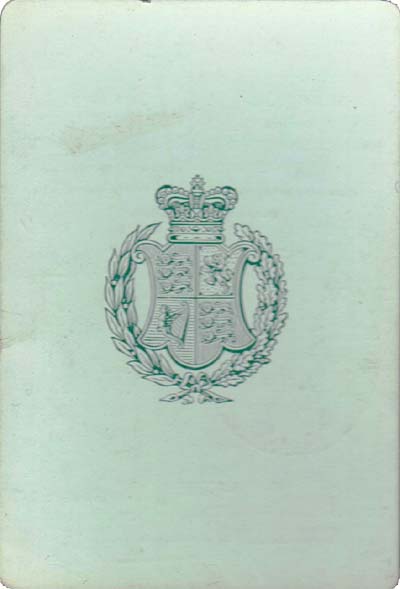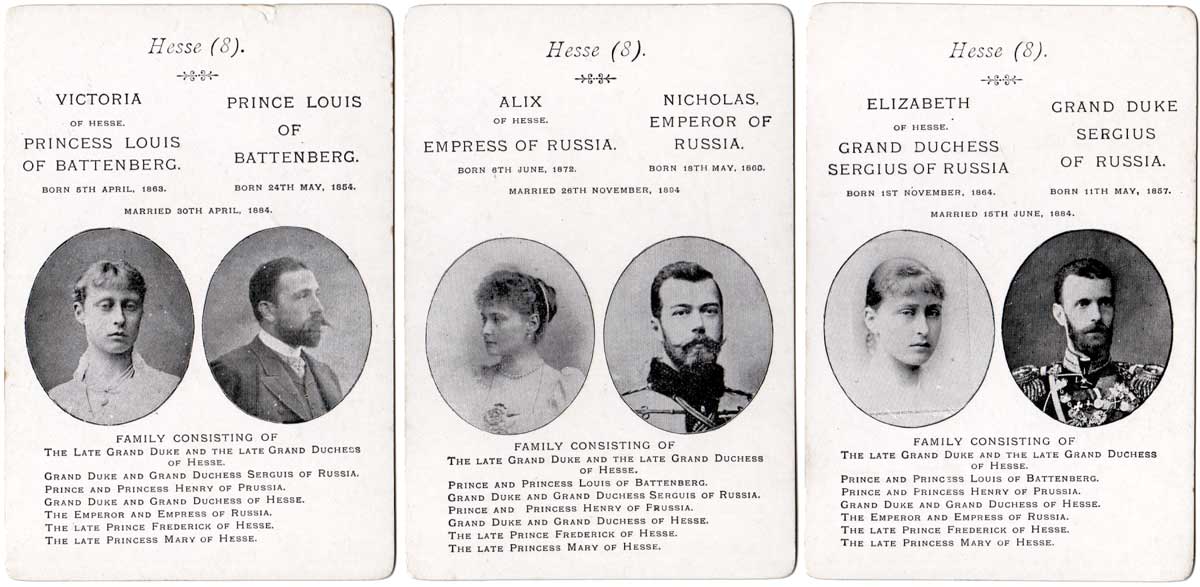A Royal Game
A Royal Game featuring Queen Victoria’s children and extended family, published by A. Collier, London, c.1896.
Superb set of Happy Families cards titled “A Royal Game,” consisting of families of Queen Victoria’s children and extended family, 1896.
A Royal Game was registered at the Patent Office on 14th Sept. 1895 by William Pitt Brook and Alfred Collier (publisher) (who also published ‘Oliver Twist Snap’ and ‘Jovial Families’).
“Our invention consists of a new or improved game to be played with cards by young people which will be both instructive and entertaining.”
See the original patent here►
(Click ‘Original Document’).


The pack contains 52 cards divided into ten groups consisting of Her Majesty, the late Prince Consort, with their children and grand-children. 1896 was the year in which Queen Victoria became the longest-reigning monarch in British history, and her Diamond Jubilee celebration would take place the next year.

Each card gives details of the name and title with dates of birth, marriage and death (if appropriate) along with an image of the person(s) concerned. To play the game, all the cards are dealt round and the dealer starts by asking any player for any card s/he may require to help complete any particular family s/he has in hand. See the Rules►

Above: cards showing Victoria and her husband Prince Louis of Battenberg together with those showing her two sisters who were killed in Russia. Prince and Princess Louis of Battenberg went on to produce Naval & Military Families►
By Rex Pitts (1940-2021)
Member since January 30, 2009
Rex's main interest was in card games, because, he said, they were cheap and easy to get hold of in his early days of collecting. He is well known for his extensive knowledge of Pepys games and his book is on the bookshelves of many.
His other interest was non-standard playing cards. He also had collections of sheet music, music CDs, models of London buses, London Transport timetables and maps and other objects that intrigued him.
Rex had a chequered career at school. He was expelled twice, on one occasion for smoking! Despite this he trained as a radio engineer and worked for the BBC in the World Service.
Later he moved into sales and worked for a firm that made all kinds of packaging, a job he enjoyed until his retirement. He became an expert on boxes and would always investigate those that held his cards. He could always recognize a box made for Pepys, which were the same as those of Alf Cooke’s Universal Playing Card Company, who printed the card games. This interest changed into an ability to make and mend boxes, which he did with great dexterity. He loved this kind of handicraft work.
His dexterity of hand and eye soon led to his making card games of his own design. He spent hours and hours carefully cutting them out and colouring them by hand.
Related Articles

Scientific Whist
“Scientific Whist” : standard cards with instructions for play on the faces by Chas Goodall & Son, 1...

Agent Provocateur
Branded lingerie collection in a pack of pin-up playing cards.

Nimbus playing cards
Mike Steer’s weather-themed pack with suits in four colours and backs for cardistry.

Agatha Christie and Playing Cards revisited
Agatha Christie uses card-play as a primary focus of a story, and as a way of creating plots and mot...

The Decadent Deck
Studies in the eroticism of the female body by Inge Clayton.

Historic Shakespeare
“Historic Shakespeare” playing cards featuring Shakespearean characters by Chas Goodall & Son.

Copechat Paramount Sorting System
Preserving the past: a specimen deck showcasing edge-notched cards and their ingenious sorting syste...

Heartsette by Herbert Fitch & Co, 1893
A glimpse into a busy print and design office in late Victorian London.

Rap Rummy
Rap Rummy made by Parker Brothers in 1926, only 4 years after the discovery of King Tutankhamen’s to...

Batman® playing cards
Batman playing cards published by InterCol of London 1989.

Can You Believe Your Eyes?
“Can You Believe Your Eyes?” playing cards featuring visual illusions & other oddities.

Pastime Playing Cards for the Blind
The “Pastime” Playing Cards for the Blind manufactured by Goodall & Son Limd., c.1910.

Polish Kings and Queens – red deck
Polish kings and queens plus the court jester, illustrated in a distinctive style inspired by histor...

The European Interchanges Quartets
A card game based around motorway intersections from European countries.

Songs with Flute accompaniment
Eighteenth century English engraved cards with music for voice and flute.

Love Tests
Vintage novelty “Love Test” cards of a slightly saucy nature but all in good fun!
Most Popular
Our top articles from the past 28 days


















